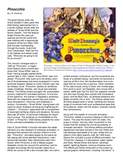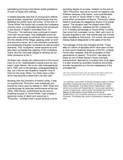The great Disney artist Joe Grant recalled in later years that Walt Disney approached him in a studio hallway shortly after the release of “Snow White and the Seven Dwarfs.” The first feature-length Disney film was just opening around the world and was meeting with a spectacular reception at the box office. With that success reverberating through the studio, Grant told John Canemaker, Walt met him in the hallway and asked cryptically: “What are we going to do for an encore?”
The “encore” emerged early in 1940 as “Pinocchio,” a magnificent feature which proved decisively that “Snow White” was no fluke. Having actually started development late in 1937, before “Snow White” was completed, “Pinocchio” fully lived up to the artistic promise of its predecessor and even surpassed it in some technical respects. Based on Carlo Collodi’s epic Italian fantasy novel, “Pinocchio” tackled an ambitious range of settings, themes, and visual and dramatic effects. The Disney writers plunged into unprecedented story material for animated cartoons. At one end of the spectrum, the scenes in Geppetto’s workshop, filled with his imaginative carved toys and clocks, were atmospheric, charming, and endlessly inventive. Conversely—“Snow White” having been criticized by some reviewers as being too frightening for children— “Pinocchio” responded with a complement of downright terrifying villains and situations. No story idea was off limits, no technical challenge too daunting to pursue. The evidence is unmistakable on the screen: in Pinocchio,” Walt Disney presents his vision of the unlimited possibilities of animation.
Part of “Snow White”’s triumph had been the establishment of a new standard of character animation, a standard that remains the industry criterion to this day. “Pinocchio,” animated largely by the same artists (along with some talented newcomers), maintained that standard. New refinements were introduced: when Pinocchio is still a lifeless puppet, Geppetto moves him around the workshop, and he dangles and swings like the wooden object he is. When he comes to life a few minutes later, he’s still a jointed wooden contrivance, but his movements are those of a sentient being—and when he becomes a real boy at film’s end, the transformation is so complete that he moves like a real boy. Other members of the cast include Jiminy Cricket, who nimbly leaps from point to point; old Geppetto, who moves with a slower, stiffer gait; the Fox and Cat, slapstick comedians who tear through their scenes with knockabout gusto; and the Blue Fairy, an ethereal presence who glides smoothly into a room. The Disney artists took all these assignments in stride, handling this diverse range of movement with such professional ease that the audience, drawn into the illusion, scarcely notices their achievement.
[...]

